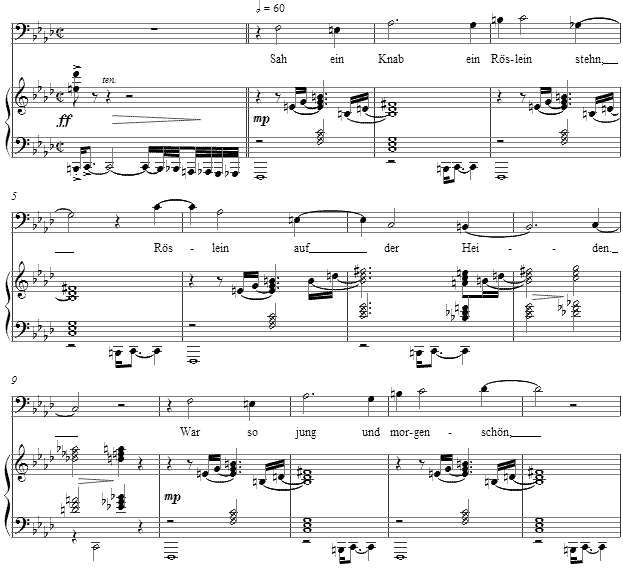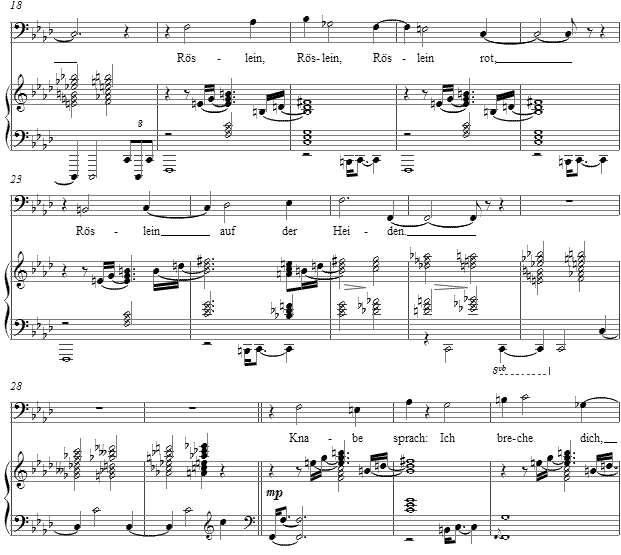Music and Texts of GARY BACHLUND
Vocal Music | Piano | Organ | Chamber Music | Orchestral | Articles and Commentary | Poems and Stories | Miscellany | FAQs
Heidenröslein - (2006)
Johann Wolfgang Goethe
for bass and piano
for bass, Randall Jakobsh
Sah ein Knab ein Röslein stehn,
Röslein auf der Heiden,
War so jung und morgenschön,
Lief er schnell, es nah zu sehn,
Sahs mit vielen Freuden.
Röslein, Röslein. Röslein rot,
Röslein auf der Heiden.
Knabe sprach: Ich breche dich,
Röslein auf der Heiden!
Röslein sprach: Ich steche dich,
Daß du ewig denkst an mich,
Und ich wills nicht leiden.
Röslein, Röslein. Röslein rot,
Röslein auf der Heiden.
Und der wilde Knabe brach
s Röslein auf der Heiden;
Röslein wehrte sich und stach,
Half ihm doch kein Weh und Ach,
Mußt es eben leiden.
Röslein, Röslein. Röslein rot,
Röslein auf der Heiden.
1770-1771 Strassburg
[ 6 pages, circa 3' 00" ]
Johann Wolfgang Goethe
Given the melodious song setting by Schubert well-known to so many singers, this text has not often been set by other composers. During a run of Zemlinsky's Der König Kandaules in which Randall Jakobsh sang the role of Pharnaces, we spoke about the text, and its possible darker sense.
A common metaphor of that time and indeed today for virginity, passion, love and femininity was the rose. Blake's poem, may be read in this manner as well, the rose and the worm being multivalent, delicately stated. Blake's poem reads:
O rose, thou art sick!
The invisible worm
That flies in the night,
In the howling storm,
Has found out thy bed
Of crimson joy,
And his dark secret love
Does thy life destroy.
Throughout time, sex has been a passion and yet a taboo, and the equating of sex with love is often misconstrued. Rather sex and its dangers, through transmitted diseases, were an oft-told story. Randall suggested a setting of this text, from the clear perspective of an attempted rape. Our "little rose" carries out her violent threat and rewards the attempted violence and rape with violence in return. With that reading and the opportunity to show off the low range of the bass voice, I chose to write a dark setting, the antithesis of Schubert's, with dense chord structures and chromatic half step movement to darken an already dark mood. Yet, because the poem is strophic in nature and carries a refrain, I chose to observe these conventions, as did Schubert, and for the same cumulative effect, even if antithetical one to the other.
The choice of a chord form to color this darker reading of the tale was crucial, in order to stand between the modern day and the older times in which the metaphor of the rose told so much. F minor stands with the E minor above it, as an example, in the second measure, and the progression from tonic to minor dominant includes B minor over the dominant of C minor. Thus a rather normal common practice harmonic principle is extended and flavored by the inclusion of a more dense chord form which colors the entire song setting. As a result of this chord form, the first notes of the melody line show the same relationship between F and E, and the lower neighbors populate the harmonies and melodic contours alike.
Written for bass voice, the final low F emphasizes the tragedy of the tale, in the reading of this tale as a human tragedy. But for whom is the tragedy? The "Knab?" Our "Röslein?" Or all for whom this all too human tale speaks of our foibles and viciousness, which lies shallow beneath the veneer of our social and moral sensitivities?
Randall Jakobsh
From British Columbia, bass Randall Jakobsh has established an international reputation with important engagements with major opera companies in Europe, South America, Canada and the United States. He has performed in Salzburg, Opéra Nancy, Festival de Musica de Gran Canarias, Teatro Colon de Buenes Aires, Teatro Liceu in Barcelona, Festival Vancouver, Washington Opera, Baltimore Opera, l’Opéra de Montréal, Vancouver Opera, and Opéra de Tours et de Lorraine.
The score to Heidenröslein is available as a free PDF download, though any major commercial performance or recording of the work is prohibited without prior arrangement with the composer. Click on the graphic below for this piano-vocal score.



